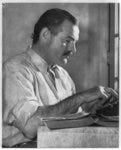How to Avoid Building Bridges to Nowhere
Take a page out of this twentieth-century writer's book.
There’s a now-closed hike that I’d been wanting to do for a while in the San Gabriel Mountains outside of LA: the Bridge to Nowhere trail.
There are apparently challenging river crossings and other exciting features in this ten-mile round-trip hike, but the most notable is a majestic, utterly random 120-foot bridge out in the Sheep Mountain Wilderness.
There used to be a road connecting to the bridge, but the devastating Los Angeles flood of 1938 washed it away. Hence the name.

Apparently, these stranded bridges, in which one or both sides are disconnected from roads or incomplete, are so common in Germany that they have a separate name for them: “soda-brücke” or “just there.”
There’s something simultaneously fascinating and tragic about these bridges. Their unfinished potential haunts me.
I’ve been guilty of building “bridges to nowhere” in my own life.
I’ve started projects with the enthusiasm of a seven-year-old entering a toy store, only to abandon them when I got stuck or the project no longer delivered the initial dopamine rush, and I had to deliver on the lofty promises I’d hastily made.
Even when I more maturely approached long-term projects like writing a novel or a script with a solid outline and better planning, it was hard to avoid the “second act slump” and keep up momentum after getting a few chapters into a novel or after writing act one of my feature script.
But in the past year, I’m learning to build more connected bridges — whether in my personal journey of self-growth or my writing projects.
One of the biggest revelations came to me in a screenwriting class I took that was hosted by Audrey Knox, a former literary manager who now uses her industry experience to help screenwriters build meaningful writing careers.

Audrey taught us the Hemingway Bridge, a technique devised by writer Ernest Hemingway to help writers maintain consistent work habits.
So many writers burn out because they keep writing until their energy is spent, then write no more. They keep waiting for magic periods of inspiration or hyperproductivity or “flow states” — whatever you want to call it.
But weeks or months go by in between these hyperproductive days, and the project languishes.
Hemingway took a different tack.
Instead of writing until his head was nodding off at his typewriter, he wrote until a point where he knew he still had energy to keep going. He finished his session before he had written everything he wanted to say, trusting his future self would be able to continue the forward momentum.
The writer trusted his future self because, after his current writing session, Hemingway would leave notes on things he wanted to work on the next time. So, he knew the next time he sat down to write, the terror of the blank page wouldn’t daunt him, because he had a roadmap for exactly where he wanted to go.
Those simple notes written down at the end of the previous writing session offer writers a bridge from chapter to chapter and rewrite to rewrite.
A Hemingway bridge might include notes on writing a transition to the following scene, a character rewrite, worldbuilding thoughts, et cetera. If you’re facing a problem, you can journal about potential ways to work through that problem in the next session. You review your notes before the beginning of the next session and go forth across the bridge.
Even though the Hemingway bridge originates in writing, you can see how it’s pretty easy to apply to other projects.
Let’s say you have a goal of achieving mastery of watercolor painting. You establish regular painting sessions, and, at the end of each attempt, you write notes on what you’d like to work on next time, such as a new watercolor technique.
My mind initially bumped up against the Hemingway bridge, because I had previously relied on bouts of ADHD hyperproductivity — usually driven by frantic urgency in the 24 hours before a deadline — to get several days of work done in one night.
But lately, my hyperproductivity had been flagging, and it wasn’t a reliable strategy anymore. I needed to work in greater moderation, or I wouldn’t get anything done at all. The Hemingway bridge came at a point in my life where I really, really needed it.
Some days, all I wrote for my notes for my next writing session was “write literally anything in Final Draft.” (Final Draft is a screenwriting software).

That’s all I needed. And maybe you need it too.
The Hemingway Bridge serves as a stepping stone or paving path from present you to future you. Without having a Hemingway bridge for projects or long-term self-improvement goals, you’ll be forever stuck on one side of a chasm, unable to get to the other side. You need an “in-between” point to help you leap to the other side.
Bridging the gap from the person we are now to the person we want to be is never easy. But I’m never going to stop trying.
Until next time…


This is a wonderful method to all kinds of thing in one's life. It's like the philosophy to always leave a little something undiscovered when traveling to new places. The urge to see and do everything can be overwhelming and exhausting so one should just do what they can with the goal to come back and see more later.
I like the element of a leap of faith involved with this, that you have to trust your future self to follow through with continuing where you leave off on a particular task